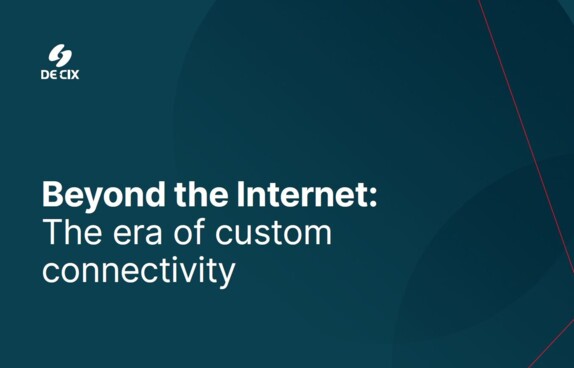Understanding the connectivity landscape of the modern enterprise
One of the major enablers of new digital products and business models for the current and future transformation of enterprises is agility. Enterprises need the flexibility to redesign the connectivity for each of their locations and operations in line with their ongoing transformation process. Connectivity used to be an enabler but, as new products are developed and portfolios evolve in modern digital business, it is becoming an intrinsic part of the product itself – take the connected car as an example. Therefore, enterprises will need even greater flexibility in all aspects of their connectivity to make it fit for the future – including the capability to adjust bandwidths, optimize latency, improve security, and reinforce the resilience of their connectivity in line with the business demands and application requirements. And creating secure and customizable connections to new business partners as and when needed. Not to mention time-independent booking and adjustment of services and intelligent automation. Comparing the new demands with legacy enterprise connectivity is a bit like comparing an elite athlete with a couch potato – sure, the couch is comfortable, but modern digital business requires strength, resilience, and flexibility to win the game.
So how is the enterprise connectivity landscape transforming? A digitally transformed factory, for example, has more data requiring storage and processing than a legacy factory. This data will most likely be stored and processed in the cloud to enable access from geographically dispersed company locations to monitor KPIs and QA in a centralized way, and to provide management with aggregated data for making decisions. As a result, modern enterprises have an increased demand for aggregating and transporting data. But beyond this, a factory is no longer the preserve of the manufacturing company alone. With concepts like robotics as a service, a factory provides a home for intelligent machines that are owned and operated by external partners. Consequently, it is necessary to optimize the connectivity not only to headquarters, branches, and production plants, but also to specific external parties. Intelligent production processes – be that the use of robots, smart quality assurance, or additive manufacturing (3D printing techniques) – place much greater demands on the resilience of the connectivity. This requires guarantees in the form of high-level service level agreements (SLAs) and dedicated bandwidth, along with flexibility.
Added to this, companies also want to consume more services from centralized clouds – indeed, from multiple cloud providers simultaneously as part of their multi-cloud strategy. In this case, end-to-end flexibility is required to guarantee the bandwidth that is actually needed for the given service. Companies today no longer think in terms of the historical A-to-B locational conception of connectivity. Instead, they require more fine-grained connectivity between applications, workloads, devices, and users. The conception of connectivity is no longer about connecting sites in, for example, two particular cities; rather, the focus is on goals like setting up connectivity between the company’s AI cluster in a centralized hyperscaler and the locally hosted on-prem SQL database.
The importance of resilient, fast, high-bandwidth, and flexible connectivity from the enterprise network to the cloud and to other digital infrastructure service providers, as well as to any service providers that are involved in the company’s digital value chains, cannot be underestimated. The evolution of modern interconnection services must follow and reflect the needs of modern business. Designing these modern interconnection services therefore needs to be approached in two ways: firstly, by creating a robust, secure, resilient, and high-performance physical infrastructure, and then by adding flexibility and simplicity through virtualization and automation, thus enabling a range of customizable services.
Resilience is essential for keeping data traffic safe and flowing
For digital business, being able to trust its connectivity infrastructure is essential. Day-to-day operations depend on fail-safe transportation of data – be that customer data, maintenance of systems, analytics, or any other of a myriad of essential data-driven use-cases. Unfortunately, in the real world incidents and outages are a part of life, and it is necessary to build connectivity in such a way as to minimize the impact of these. Just as a resilient immune system helps the body to avoid infection or to bounce back rapidly from health-related setbacks, connectivity requires its own form of resilience. Through building multiple layers of redundancy – in terms of technology, geography, and also in terms of business partners – a company can design its critical digital infrastructure to be more immune to real-world events.
Sounds great, you say, but how is this even possible? Redundancy, neutrality, and diversity in digital infrastructure are key to the greatest level of resilience. This must be factored into the design of enterprise connectivity from top to bottom. Take what we do at DE-CIX as an example: Physical redundancy is an essential hallmark of the design of DE-CIX platforms, necessary to support the SLAs we guarantee our customers. The distributed nature of our platforms, accessible in many different geographically dispersed data centers, together with the redundant deployment of our own core and edge infrastructure, ensures resilience against localized outages. Furthermore, we purchase connections as diversely as possible along multiple different routes, so that even in the case of localized outages along one pathway, connectivity can be maintained between locations. This means we ensure redundant and non-overlapping cable connections between every data center where our platform is accessible, creating a highly robust and resilient, failure-safe interconnection environment. We seek the highest levels of diversity on multiple levels: different operators, different cable stretches, and different upstream products. Interconnecting our platforms globally, the same applies: we share our capacities across different sub-sea cable routes and ensure that these paths do not overlap at any point. This best practice approach should also be applied by enterprises if they want to ensure resilient connectivity for their critical data flows and value chains – the foundation of business continuity in the digital economy.
One access, multiple services – how enterprises can get what they need when they need it
Bearing in mind the need for resilient connectivity, it is not surprising that enterprises are looking for secure and resilient alternative means to access their chosen cloud services. The demand for private cloud connectivity is constantly growing, and digital businesses meanwhile understand the pitfalls of connecting to clouds via the public Internet. At the same time, flexibility and simplicity in the handling of interconnection services is paramount to enterprise agility. An access model (one access, multiple services) for the booking of interconnection services, paired with a self-service portal and API capabilities, ensures the easy booking, scaling, and adjusting of services. This makes a multi-cloud strategy feasible and manageable, as well as simplifying general interconnection.
No matter whether it’s for direct access to hyperscale and specialized clouds, for sourcing and using specific applications from the cloud (like Microsoft 365), or for securely connecting and exchanging data with business partners in a secure and exclusive environment, enterprises require a dedicated infrastructure to consume the services they are using. Therefore, even when the underlying infrastructure is necessarily shared (such as the global Internet backbone, and interconnection platforms like those operated by DE-CIX), enterprise customers need a virtual point-to-point private line, meaning that the enterprise connectivity is logically separated and has guaranteed reserve bandwidth on the infrastructure. Looking forward, the further evolution of cloud connectivity will involve greater interoperability and cloud-to-cloud communication.
Technology-neutral integration enabling the service edge
What is needed to fulfill the interconnection needs of the enterprises of the future is technology-neutral integration enabling the service edge. Here again, DE-CIX, the world’s leading operator of neutral interconnection platforms, can stand as a model. The DE-CIX ecosystems play home to all the digital service providers that the business world needs access to – the data centers, the network operators, the cloud and content providers, the content distribution networks, and many, many more. Our responsibility as an innovative interconnection specialist is to provide flexible integrated solutions, in terms of on-demand network as a service, also to customers that are beyond the scope of traditional interconnection services. The best way for enterprises to ensure the greatest resilience of their own connectivity to locations, partners, and resources in the cloud is to not only build out their redundant connectivity with multiple contractual partners, but also to capitalize on the redundancy and diversity built into the distributed and neutral nature of the DE-CIX infrastructure. As an agile facilitator, an interconnection specialist like DE-CIX can simplify and streamline the process of creating resilient connectivity for the digital transformation challenges of the modern enterprise.

